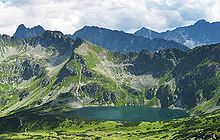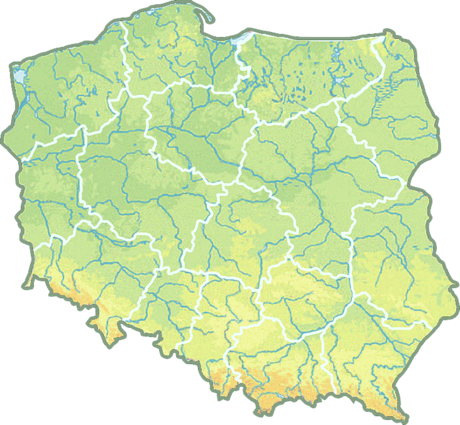Poland

Republic of Poland , is a country in Central Europe bordered by Germany to the west; the Czech Republic and Slovakia to the south; Ukraine and Belarus to the east; and the Baltic Sea, Kaliningrad Oblast (a Russian exclave) andLithuania to the north. The total area of Poland is 312,679 square kilometres (120,726 sq mi),[8] making it the 71st largest country in the world and the 9th largest in Europe. With a population of over 38.5 million people,[8] Poland is the 34th most populous country in the world,[10] the sixth most populous member of the European Union, and the most populous post-communist member of the European Union. Poland is a unitary state divided into 16 administrative subdivisions.


Geography and Climate
Poland's territory extends across several geographical regions, between latitudes 49° and 55° N, and longitudes 14° and 25° E. In the north-west is the Baltic seacoast, which extends from the Bay of Pomerania to the Gulf of Gdańsk. This coast is marked by several spits, coastal lakes (former bays that have been cut off from the sea), and dunes. The largely straight coastline is indented by theSzczecin Lagoon, the Bay of Puck, and the Vistula Lagoon. The centre and parts of the north lie within the North European Plain.
The climate is mostly temperate throughout the country. The climate is oceanic in the north and west and becomes gradually warmer and continental towards the south and east. Summers are generally warm, with average temperatures between 18 and 30 °C (64.4 and 86.0 °F) depending on a region. Winters are rather cold, with average temperatures around 3 °C (37.4 °F) in the northwest and −6 °C (21 °F) in the northeast. Precipitation falls throughout the year, although, especially in the east; winter is drier than summer.[91]
The warmest region in Poland is Lower Silesia located in south-western Poland where temperatures in the summer average between 24 and 32 °C (75 and 90 °F) but can go as high as 34 to 39 °C (93.2 to 102.2 °F) on some days in the warmest month of July and August. The warmest cities in Poland are Tarnów, which is situated in Lesser Poland and Wrocław, which is located in Lower Silesia. The average temperatures in Wrocław are 20 °C (68 °F) in the summer and 0 °C (32.0 °F) in the winter, but Tarnów has the longest summer in all of Poland, which lasts for 115 days, from mid-May to mid-September. The coldest region of Poland is in the northeast in the Podlaskie Voivodeship near the border of Belarus and Lithuania. Usually the coldest city is Suwałki. The climate is affected by cold fronts which come from Scandinaviaand Siberia. The average temperature in the winter in Podlaskie ranges from −6 to −4 °C (21 to 25 °F).

Politics
Poland is a democracy, with a president as a head of state, whose current constitution dates from 1997. Poland is a peaceful country. The government structure centers on the Council of Ministers, led by a prime minister. The president appoints the cabinet according to the proposals of the prime minister, typically from the majority coalition in the Sejm. The president is elected by popular vote every five years. The president is Bronisław Komorowski. Komorowski replaced President Lech Kaczyński following the latter's death in an 10 April 2010 air crash. Since 2007 Polish government has been formed by the Civic Platform party. The current prime minister, Ewa Kopacz, was appointed in 2014.

Administrative Divisions
Poland's current voivodeships (provinces) are largely based on the country's historic regions, whereas those of the past two decades (to 1998) had been centred on and named for individual cities. The new units range in area from less than 10,000 square kilometres (3,900 sq mi) for Opole Voivodeship to more than 35,000 square kilometres (14,000 sq mi) for Masovian Voivodeship. Administrative authority at voivodeship level is shared between a government-appointed voivode (governor), an elected regional assembly (sejmik) and an executive elected by that assembly.
The voivodeships are subdivided into powiats (often referred to in English as counties), and these are further divided into gminas (also known as communes or municipalities). Major cities normally have the status of both gmina and powiat. Poland has 16 voivodeships, 379 powiats (including 65 cities with powiat status), and 2,478 gminas.
Tourism
Poland experienced an increase in the number of tourists after joining the European Union.[151] Tourism in Poland contributes to the country's overall economy and makes up a relatively large proportion of the country's service market.[152]


Poland's main tourist offerings include qualified tourism such as skiing, sailing and mountain hiking, as well as agrotourism, sightseeing walks, countryside excursions, as well as holiday and business trips. It is the 17th most visited country in the world by foreign tourists, as ranked by World Tourism Organization (UNWTO) in 2012.[154] Tourist destinations include Baltic Sea coast in the north of Poland, Masurian Lake District and Białowieża Forest in the east, the northern Karkonosze, Table Mountains, Tatra Mountains, in which has the highest peak of Polish (Rysy) and the famous Orla Perć; Pieniny as well as Bieszczady Mountains in the extreme south-east.[155] There are over 100 castles in the country, many along the popular Trail of the Eagles' Nests.[156]
Religion

From its beginnings, Poland has contributed substantially to the development of religious freedom. Since the country adopted Christianity in 966, it was also welcoming to other religions through a series of laws: Statute of Kalisz (1264), Warsaw Confederation (1573). However, the Polish king Władysław II Jagiełło was pressed by the Catholic Church to issue the Edict of Wieluń (1424), outlawing early Protestant Hussitism. Polish theological thought include theological movements, such as CalvinistPolish Brethren and a number of other Protestant groups, as well as atheists, such as ex-Jesuit philosopher Kazimierz Łyszczyński, one of the first atheist thinkers in Europe.
Education



The Commission of National Education (Komisja Edukacji Narodowej) established in 1773, was the world's first state ministry of education.[195][196] The education of Polish society was a goal of rulers as early as the 12th century. Poland became one of the most educated countries in Europe. The library catalogue of the Cathedral Chapter of Kraków dating back to 1110 shows that in the early 12th-century Polish intellectuals had access to European literature. The Jagiellonian University, founded in 1364 by King Casimir III in Kraków was blessed by Pope Urban V. It is the world's 19th oldest university.
The modern-day Programme for International Student Assessment, coordinated by the Organisation for Economic Co-operation and Development, ranks Poland's educational system in its PISA 2012as the 10th best in the world,[197] scoring higher than the OECD average.[198]


